Operation and Project Management Strategies for XYZ Company Report
VerifiedAdded on 2020/06/06
|13
|4004
|103
Report
AI Summary
This report provides a comprehensive analysis of operation and project management within XYZ Company. It begins with an introduction to operational management principles, emphasizing their importance in organizational activities, particularly within a large-scale enterprise like XYZ Company, which focuses on marketing, promotion, and sales of various products. The report then delves into Task 1, exploring the potential of operational management principles, including reality, organization, fundamental practices, accountability, variance, creativity, humanity, success, and change, as well as the application of Six Sigma and Lean principles. Task 2 focuses on preparing a continuous plan and reviewing operational management strategies, including promotional events, after-sales customer services, and continuous improvement plans. Finally, Task 3 examines the stages of the product life cycle (PLC) for completing a business case, specifically regarding XYZ Company's plan to introduce a new television product, and the application of the PLC in managing the product's development and market entry. The report covers all the major aspects of project and operation management, including strategies and plans for the company to improve its business.
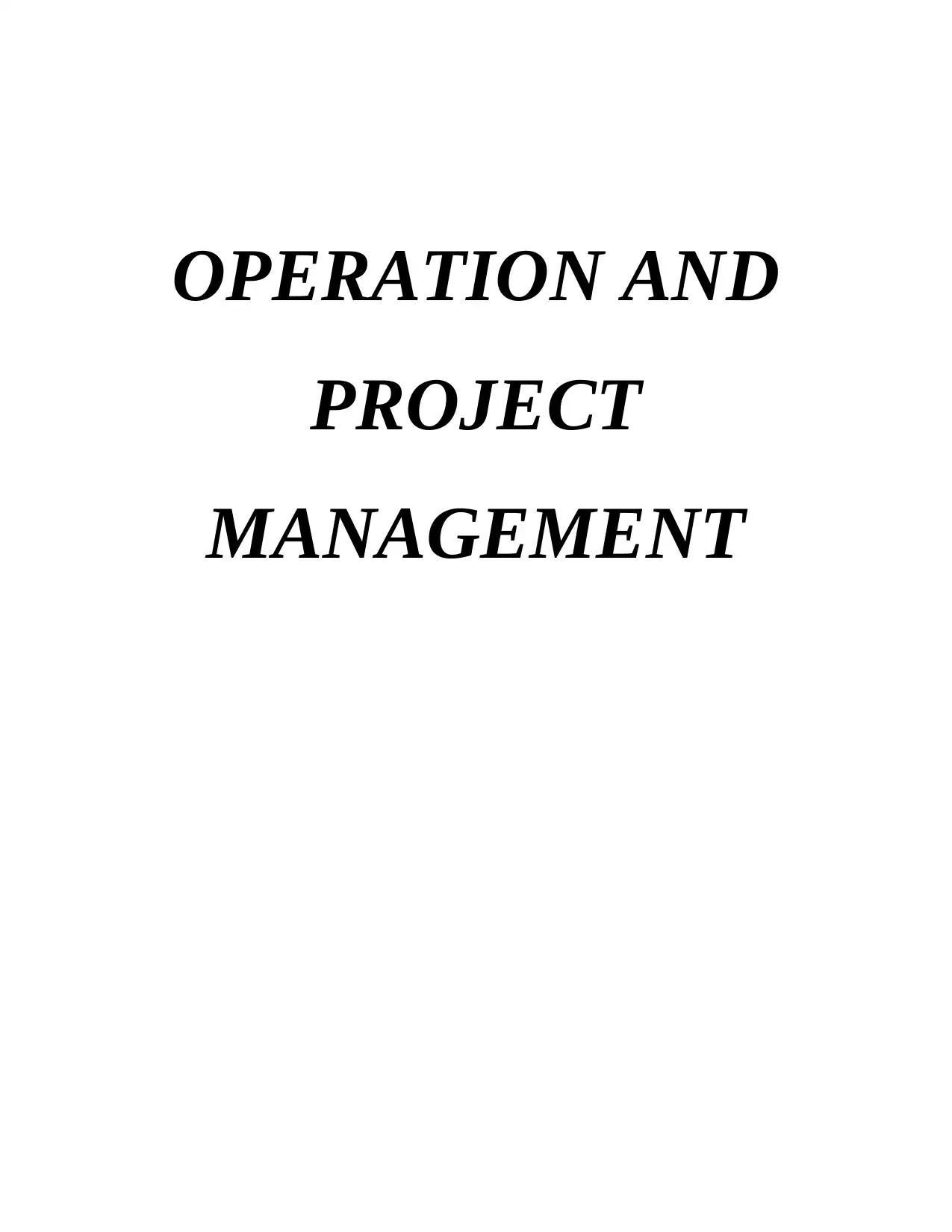
OPERATION AND
PROJECT
MANAGEMENT
PROJECT
MANAGEMENT
Paraphrase This Document
Need a fresh take? Get an instant paraphrase of this document with our AI Paraphraser
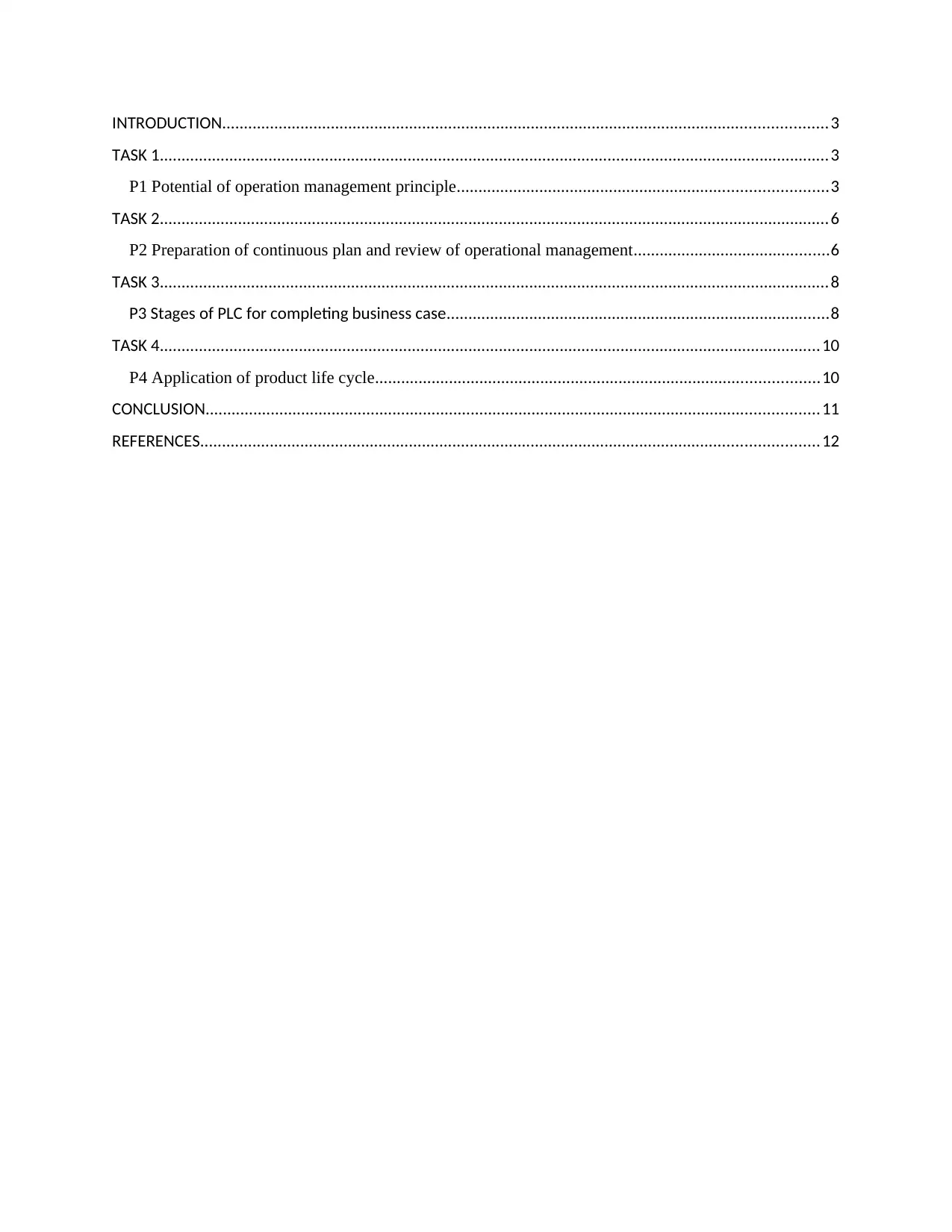
INTRODUCTION...........................................................................................................................................3
TASK 1..........................................................................................................................................................3
P1 Potential of operation management principle.....................................................................................3
TASK 2..........................................................................................................................................................6
P2 Preparation of continuous plan and review of operational management.............................................6
TASK 3..........................................................................................................................................................8
P3 Stages of PLC for completing business case........................................................................................8
TASK 4........................................................................................................................................................10
P4 Application of product life cycle......................................................................................................10
CONCLUSION.............................................................................................................................................11
REFERENCES..............................................................................................................................................12
TASK 1..........................................................................................................................................................3
P1 Potential of operation management principle.....................................................................................3
TASK 2..........................................................................................................................................................6
P2 Preparation of continuous plan and review of operational management.............................................6
TASK 3..........................................................................................................................................................8
P3 Stages of PLC for completing business case........................................................................................8
TASK 4........................................................................................................................................................10
P4 Application of product life cycle......................................................................................................10
CONCLUSION.............................................................................................................................................11
REFERENCES..............................................................................................................................................12
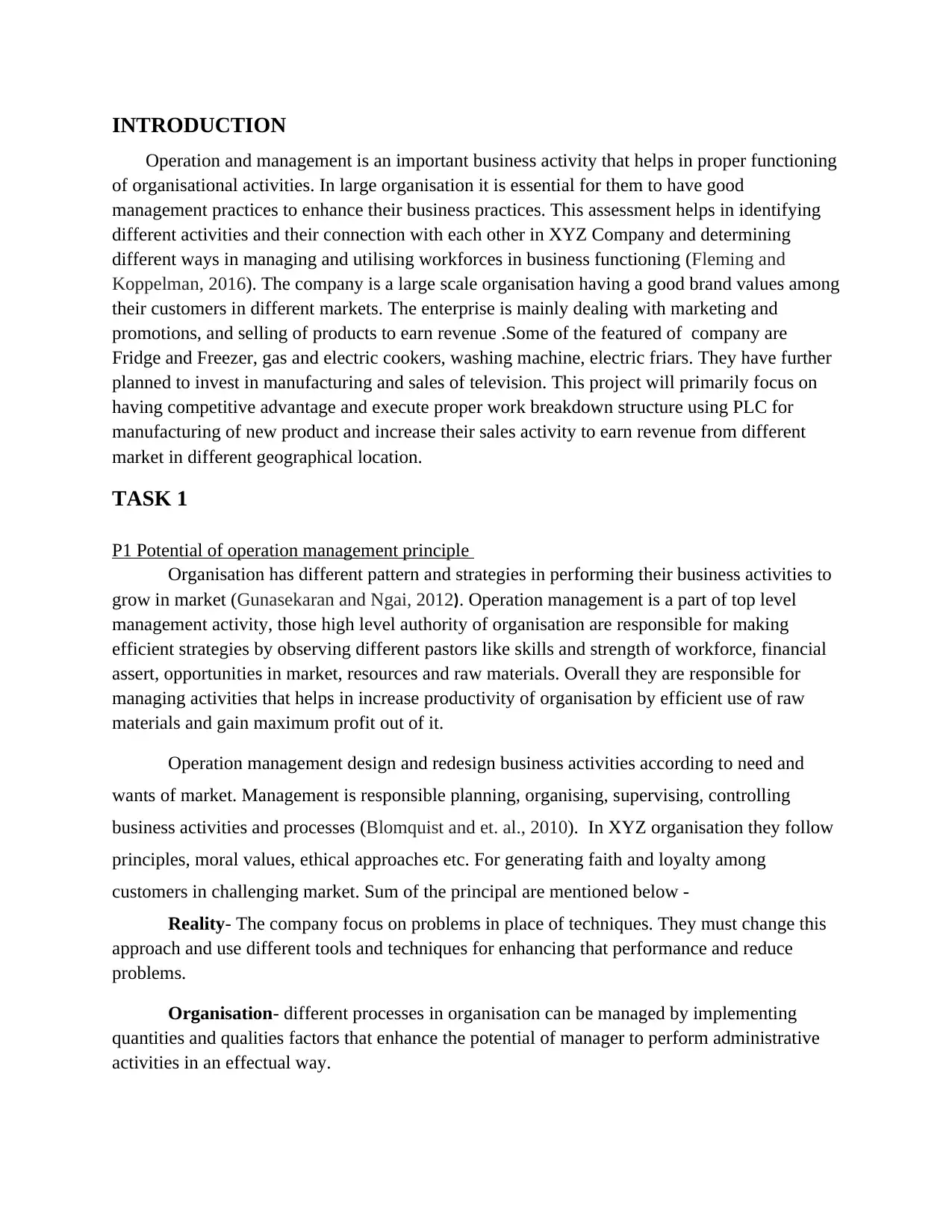
INTRODUCTION
Operation and management is an important business activity that helps in proper functioning
of organisational activities. In large organisation it is essential for them to have good
management practices to enhance their business practices. This assessment helps in identifying
different activities and their connection with each other in XYZ Company and determining
different ways in managing and utilising workforces in business functioning (Fleming and
Koppelman, 2016). The company is a large scale organisation having a good brand values among
their customers in different markets. The enterprise is mainly dealing with marketing and
promotions, and selling of products to earn revenue .Some of the featured of company are
Fridge and Freezer, gas and electric cookers, washing machine, electric friars. They have further
planned to invest in manufacturing and sales of television. This project will primarily focus on
having competitive advantage and execute proper work breakdown structure using PLC for
manufacturing of new product and increase their sales activity to earn revenue from different
market in different geographical location.
TASK 1
P1 Potential of operation management principle
Organisation has different pattern and strategies in performing their business activities to
grow in market (Gunasekaran and Ngai, 2012). Operation management is a part of top level
management activity, those high level authority of organisation are responsible for making
efficient strategies by observing different pastors like skills and strength of workforce, financial
assert, opportunities in market, resources and raw materials. Overall they are responsible for
managing activities that helps in increase productivity of organisation by efficient use of raw
materials and gain maximum profit out of it.
Operation management design and redesign business activities according to need and
wants of market. Management is responsible planning, organising, supervising, controlling
business activities and processes (Blomquist and et. al., 2010). In XYZ organisation they follow
principles, moral values, ethical approaches etc. For generating faith and loyalty among
customers in challenging market. Sum of the principal are mentioned below -
Reality- The company focus on problems in place of techniques. They must change this
approach and use different tools and techniques for enhancing that performance and reduce
problems.
Organisation- different processes in organisation can be managed by implementing
quantities and qualities factors that enhance the potential of manager to perform administrative
activities in an effectual way.
Operation and management is an important business activity that helps in proper functioning
of organisational activities. In large organisation it is essential for them to have good
management practices to enhance their business practices. This assessment helps in identifying
different activities and their connection with each other in XYZ Company and determining
different ways in managing and utilising workforces in business functioning (Fleming and
Koppelman, 2016). The company is a large scale organisation having a good brand values among
their customers in different markets. The enterprise is mainly dealing with marketing and
promotions, and selling of products to earn revenue .Some of the featured of company are
Fridge and Freezer, gas and electric cookers, washing machine, electric friars. They have further
planned to invest in manufacturing and sales of television. This project will primarily focus on
having competitive advantage and execute proper work breakdown structure using PLC for
manufacturing of new product and increase their sales activity to earn revenue from different
market in different geographical location.
TASK 1
P1 Potential of operation management principle
Organisation has different pattern and strategies in performing their business activities to
grow in market (Gunasekaran and Ngai, 2012). Operation management is a part of top level
management activity, those high level authority of organisation are responsible for making
efficient strategies by observing different pastors like skills and strength of workforce, financial
assert, opportunities in market, resources and raw materials. Overall they are responsible for
managing activities that helps in increase productivity of organisation by efficient use of raw
materials and gain maximum profit out of it.
Operation management design and redesign business activities according to need and
wants of market. Management is responsible planning, organising, supervising, controlling
business activities and processes (Blomquist and et. al., 2010). In XYZ organisation they follow
principles, moral values, ethical approaches etc. For generating faith and loyalty among
customers in challenging market. Sum of the principal are mentioned below -
Reality- The company focus on problems in place of techniques. They must change this
approach and use different tools and techniques for enhancing that performance and reduce
problems.
Organisation- different processes in organisation can be managed by implementing
quantities and qualities factors that enhance the potential of manager to perform administrative
activities in an effectual way.
⊘ This is a preview!⊘
Do you want full access?
Subscribe today to unlock all pages.

Trusted by 1+ million students worldwide
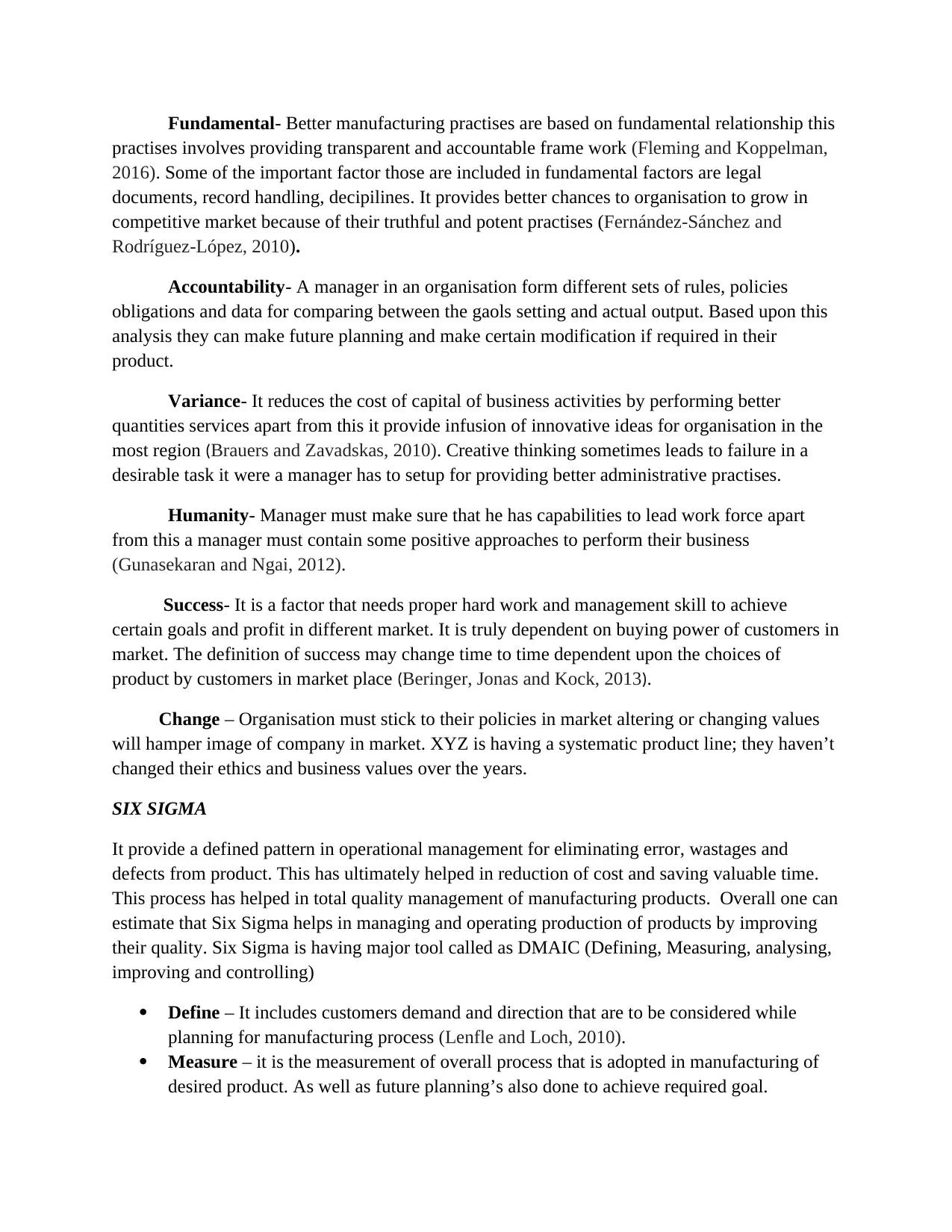
Fundamental- Better manufacturing practises are based on fundamental relationship this
practises involves providing transparent and accountable frame work (Fleming and Koppelman,
2016). Some of the important factor those are included in fundamental factors are legal
documents, record handling, decipilines. It provides better chances to organisation to grow in
competitive market because of their truthful and potent practises (Fernández-Sánchez and
Rodríguez-López, 2010).
Accountability- A manager in an organisation form different sets of rules, policies
obligations and data for comparing between the gaols setting and actual output. Based upon this
analysis they can make future planning and make certain modification if required in their
product.
Variance- It reduces the cost of capital of business activities by performing better
quantities services apart from this it provide infusion of innovative ideas for organisation in the
most region (Brauers and Zavadskas, 2010). Creative thinking sometimes leads to failure in a
desirable task it were a manager has to setup for providing better administrative practises.
Humanity- Manager must make sure that he has capabilities to lead work force apart
from this a manager must contain some positive approaches to perform their business
(Gunasekaran and Ngai, 2012).
Success- It is a factor that needs proper hard work and management skill to achieve
certain goals and profit in different market. It is truly dependent on buying power of customers in
market. The definition of success may change time to time dependent upon the choices of
product by customers in market place (Beringer, Jonas and Kock, 2013).
Change – Organisation must stick to their policies in market altering or changing values
will hamper image of company in market. XYZ is having a systematic product line; they haven’t
changed their ethics and business values over the years.
SIX SIGMA
It provide a defined pattern in operational management for eliminating error, wastages and
defects from product. This has ultimately helped in reduction of cost and saving valuable time.
This process has helped in total quality management of manufacturing products. Overall one can
estimate that Six Sigma helps in managing and operating production of products by improving
their quality. Six Sigma is having major tool called as DMAIC (Defining, Measuring, analysing,
improving and controlling)
Define – It includes customers demand and direction that are to be considered while
planning for manufacturing process (Lenfle and Loch, 2010).
Measure – it is the measurement of overall process that is adopted in manufacturing of
desired product. As well as future planning’s also done to achieve required goal.
practises involves providing transparent and accountable frame work (Fleming and Koppelman,
2016). Some of the important factor those are included in fundamental factors are legal
documents, record handling, decipilines. It provides better chances to organisation to grow in
competitive market because of their truthful and potent practises (Fernández-Sánchez and
Rodríguez-López, 2010).
Accountability- A manager in an organisation form different sets of rules, policies
obligations and data for comparing between the gaols setting and actual output. Based upon this
analysis they can make future planning and make certain modification if required in their
product.
Variance- It reduces the cost of capital of business activities by performing better
quantities services apart from this it provide infusion of innovative ideas for organisation in the
most region (Brauers and Zavadskas, 2010). Creative thinking sometimes leads to failure in a
desirable task it were a manager has to setup for providing better administrative practises.
Humanity- Manager must make sure that he has capabilities to lead work force apart
from this a manager must contain some positive approaches to perform their business
(Gunasekaran and Ngai, 2012).
Success- It is a factor that needs proper hard work and management skill to achieve
certain goals and profit in different market. It is truly dependent on buying power of customers in
market. The definition of success may change time to time dependent upon the choices of
product by customers in market place (Beringer, Jonas and Kock, 2013).
Change – Organisation must stick to their policies in market altering or changing values
will hamper image of company in market. XYZ is having a systematic product line; they haven’t
changed their ethics and business values over the years.
SIX SIGMA
It provide a defined pattern in operational management for eliminating error, wastages and
defects from product. This has ultimately helped in reduction of cost and saving valuable time.
This process has helped in total quality management of manufacturing products. Overall one can
estimate that Six Sigma helps in managing and operating production of products by improving
their quality. Six Sigma is having major tool called as DMAIC (Defining, Measuring, analysing,
improving and controlling)
Define – It includes customers demand and direction that are to be considered while
planning for manufacturing process (Lenfle and Loch, 2010).
Measure – it is the measurement of overall process that is adopted in manufacturing of
desired product. As well as future planning’s also done to achieve required goal.
Paraphrase This Document
Need a fresh take? Get an instant paraphrase of this document with our AI Paraphraser
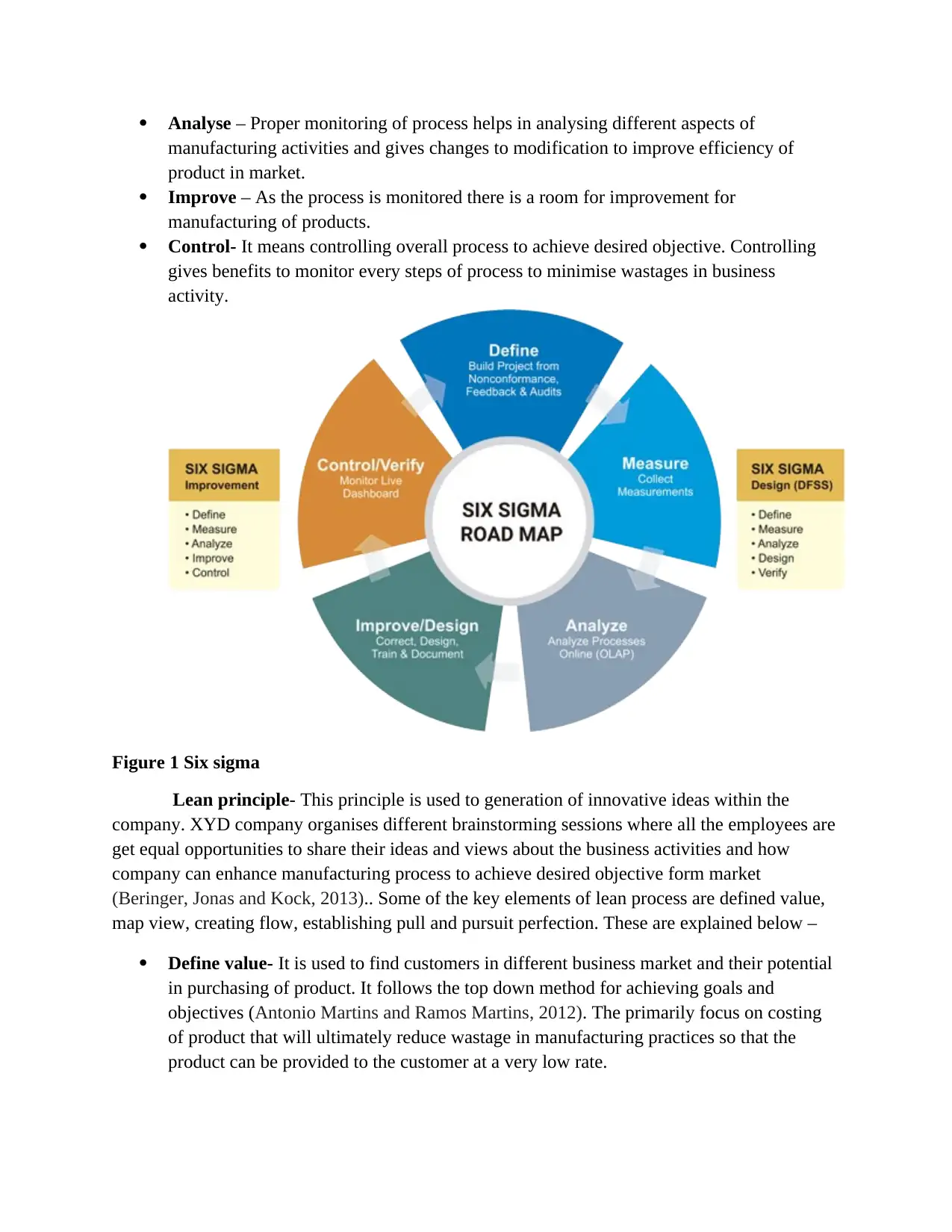
Analyse – Proper monitoring of process helps in analysing different aspects of
manufacturing activities and gives changes to modification to improve efficiency of
product in market.
Improve – As the process is monitored there is a room for improvement for
manufacturing of products.
Control- It means controlling overall process to achieve desired objective. Controlling
gives benefits to monitor every steps of process to minimise wastages in business
activity.
Figure 1 Six sigma
Lean principle- This principle is used to generation of innovative ideas within the
company. XYD company organises different brainstorming sessions where all the employees are
get equal opportunities to share their ideas and views about the business activities and how
company can enhance manufacturing process to achieve desired objective form market
(Beringer, Jonas and Kock, 2013).. Some of the key elements of lean process are defined value,
map view, creating flow, establishing pull and pursuit perfection. These are explained below –
Define value- It is used to find customers in different business market and their potential
in purchasing of product. It follows the top down method for achieving goals and
objectives (Antonio Martins and Ramos Martins, 2012). The primarily focus on costing
of product that will ultimately reduce wastage in manufacturing practices so that the
product can be provided to the customer at a very low rate.
manufacturing activities and gives changes to modification to improve efficiency of
product in market.
Improve – As the process is monitored there is a room for improvement for
manufacturing of products.
Control- It means controlling overall process to achieve desired objective. Controlling
gives benefits to monitor every steps of process to minimise wastages in business
activity.
Figure 1 Six sigma
Lean principle- This principle is used to generation of innovative ideas within the
company. XYD company organises different brainstorming sessions where all the employees are
get equal opportunities to share their ideas and views about the business activities and how
company can enhance manufacturing process to achieve desired objective form market
(Beringer, Jonas and Kock, 2013).. Some of the key elements of lean process are defined value,
map view, creating flow, establishing pull and pursuit perfection. These are explained below –
Define value- It is used to find customers in different business market and their potential
in purchasing of product. It follows the top down method for achieving goals and
objectives (Antonio Martins and Ramos Martins, 2012). The primarily focus on costing
of product that will ultimately reduce wastage in manufacturing practices so that the
product can be provided to the customer at a very low rate.
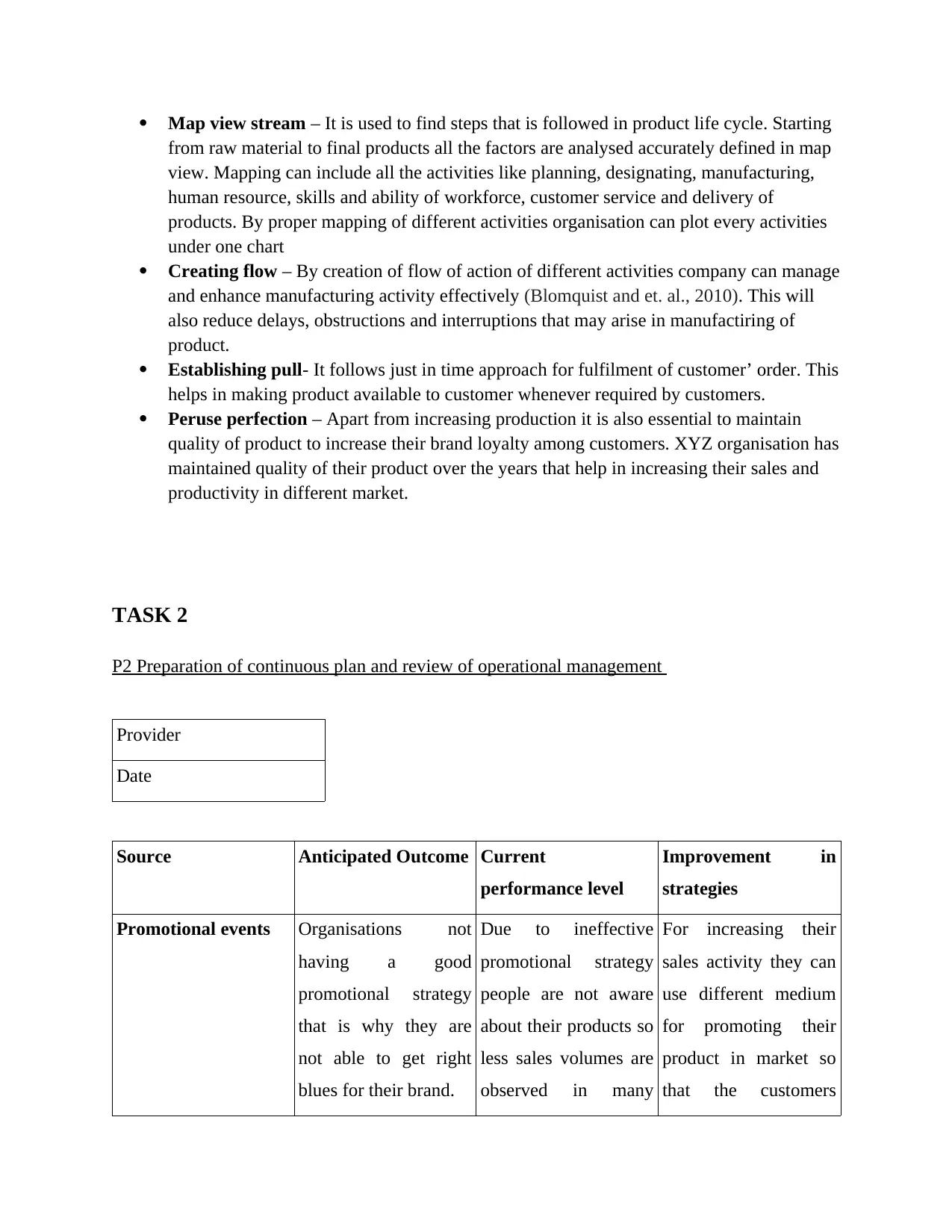
Map view stream – It is used to find steps that is followed in product life cycle. Starting
from raw material to final products all the factors are analysed accurately defined in map
view. Mapping can include all the activities like planning, designating, manufacturing,
human resource, skills and ability of workforce, customer service and delivery of
products. By proper mapping of different activities organisation can plot every activities
under one chart
Creating flow – By creation of flow of action of different activities company can manage
and enhance manufacturing activity effectively (Blomquist and et. al., 2010). This will
also reduce delays, obstructions and interruptions that may arise in manufactiring of
product.
Establishing pull- It follows just in time approach for fulfilment of customer’ order. This
helps in making product available to customer whenever required by customers.
Peruse perfection – Apart from increasing production it is also essential to maintain
quality of product to increase their brand loyalty among customers. XYZ organisation has
maintained quality of their product over the years that help in increasing their sales and
productivity in different market.
TASK 2
P2 Preparation of continuous plan and review of operational management
Provider
Date
Source Anticipated Outcome Current
performance level
Improvement in
strategies
Promotional events Organisations not
having a good
promotional strategy
that is why they are
not able to get right
blues for their brand.
Due to ineffective
promotional strategy
people are not aware
about their products so
less sales volumes are
observed in many
For increasing their
sales activity they can
use different medium
for promoting their
product in market so
that the customers
from raw material to final products all the factors are analysed accurately defined in map
view. Mapping can include all the activities like planning, designating, manufacturing,
human resource, skills and ability of workforce, customer service and delivery of
products. By proper mapping of different activities organisation can plot every activities
under one chart
Creating flow – By creation of flow of action of different activities company can manage
and enhance manufacturing activity effectively (Blomquist and et. al., 2010). This will
also reduce delays, obstructions and interruptions that may arise in manufactiring of
product.
Establishing pull- It follows just in time approach for fulfilment of customer’ order. This
helps in making product available to customer whenever required by customers.
Peruse perfection – Apart from increasing production it is also essential to maintain
quality of product to increase their brand loyalty among customers. XYZ organisation has
maintained quality of their product over the years that help in increasing their sales and
productivity in different market.
TASK 2
P2 Preparation of continuous plan and review of operational management
Provider
Date
Source Anticipated Outcome Current
performance level
Improvement in
strategies
Promotional events Organisations not
having a good
promotional strategy
that is why they are
not able to get right
blues for their brand.
Due to ineffective
promotional strategy
people are not aware
about their products so
less sales volumes are
observed in many
For increasing their
sales activity they can
use different medium
for promoting their
product in market so
that the customers
⊘ This is a preview!⊘
Do you want full access?
Subscribe today to unlock all pages.

Trusted by 1+ million students worldwide
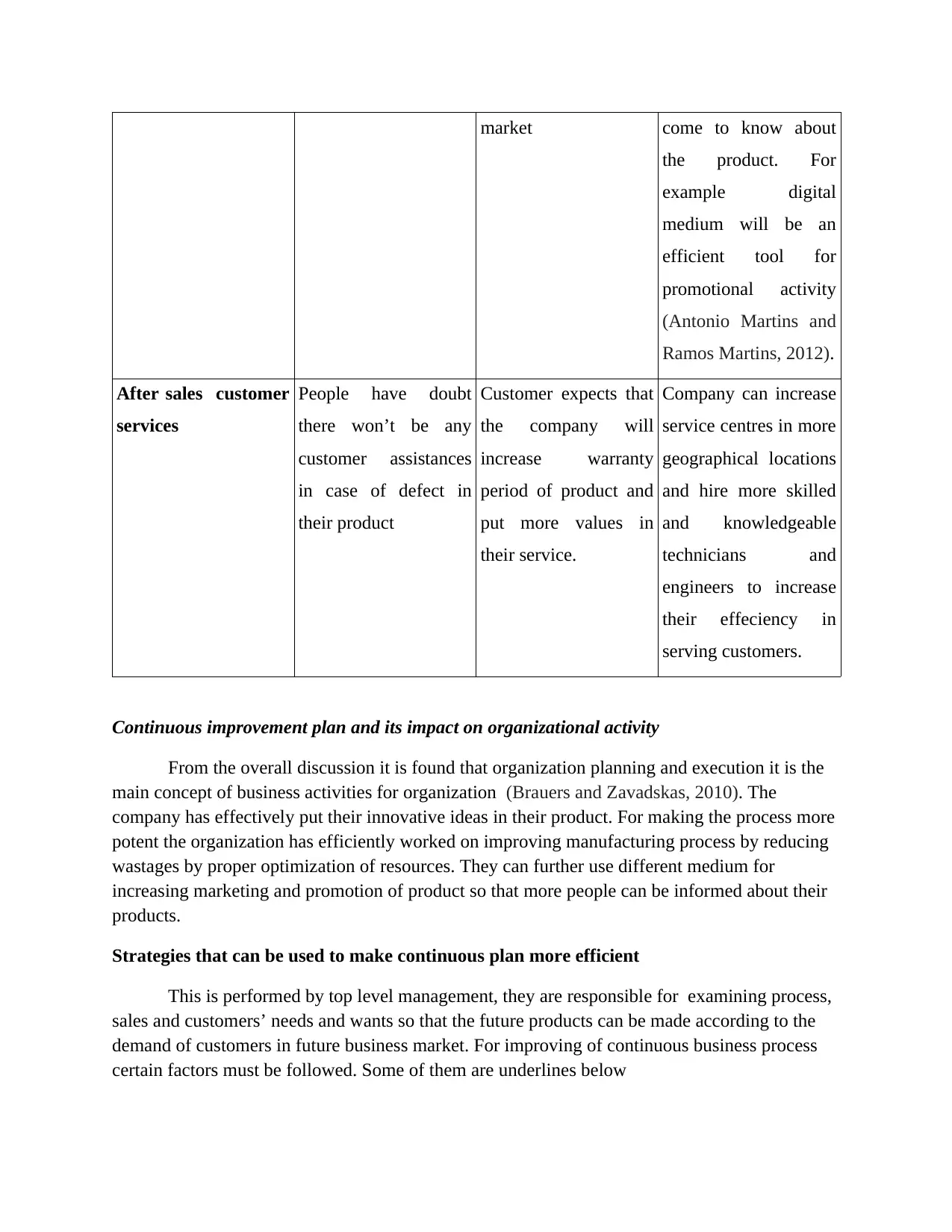
market come to know about
the product. For
example digital
medium will be an
efficient tool for
promotional activity
(Antonio Martins and
Ramos Martins, 2012).
After sales customer
services
People have doubt
there won’t be any
customer assistances
in case of defect in
their product
Customer expects that
the company will
increase warranty
period of product and
put more values in
their service.
Company can increase
service centres in more
geographical locations
and hire more skilled
and knowledgeable
technicians and
engineers to increase
their effeciency in
serving customers.
Continuous improvement plan and its impact on organizational activity
From the overall discussion it is found that organization planning and execution it is the
main concept of business activities for organization (Brauers and Zavadskas, 2010). The
company has effectively put their innovative ideas in their product. For making the process more
potent the organization has efficiently worked on improving manufacturing process by reducing
wastages by proper optimization of resources. They can further use different medium for
increasing marketing and promotion of product so that more people can be informed about their
products.
Strategies that can be used to make continuous plan more efficient
This is performed by top level management, they are responsible for examining process,
sales and customers’ needs and wants so that the future products can be made according to the
demand of customers in future business market. For improving of continuous business process
certain factors must be followed. Some of them are underlines below
the product. For
example digital
medium will be an
efficient tool for
promotional activity
(Antonio Martins and
Ramos Martins, 2012).
After sales customer
services
People have doubt
there won’t be any
customer assistances
in case of defect in
their product
Customer expects that
the company will
increase warranty
period of product and
put more values in
their service.
Company can increase
service centres in more
geographical locations
and hire more skilled
and knowledgeable
technicians and
engineers to increase
their effeciency in
serving customers.
Continuous improvement plan and its impact on organizational activity
From the overall discussion it is found that organization planning and execution it is the
main concept of business activities for organization (Brauers and Zavadskas, 2010). The
company has effectively put their innovative ideas in their product. For making the process more
potent the organization has efficiently worked on improving manufacturing process by reducing
wastages by proper optimization of resources. They can further use different medium for
increasing marketing and promotion of product so that more people can be informed about their
products.
Strategies that can be used to make continuous plan more efficient
This is performed by top level management, they are responsible for examining process,
sales and customers’ needs and wants so that the future products can be made according to the
demand of customers in future business market. For improving of continuous business process
certain factors must be followed. Some of them are underlines below
Paraphrase This Document
Need a fresh take? Get an instant paraphrase of this document with our AI Paraphraser
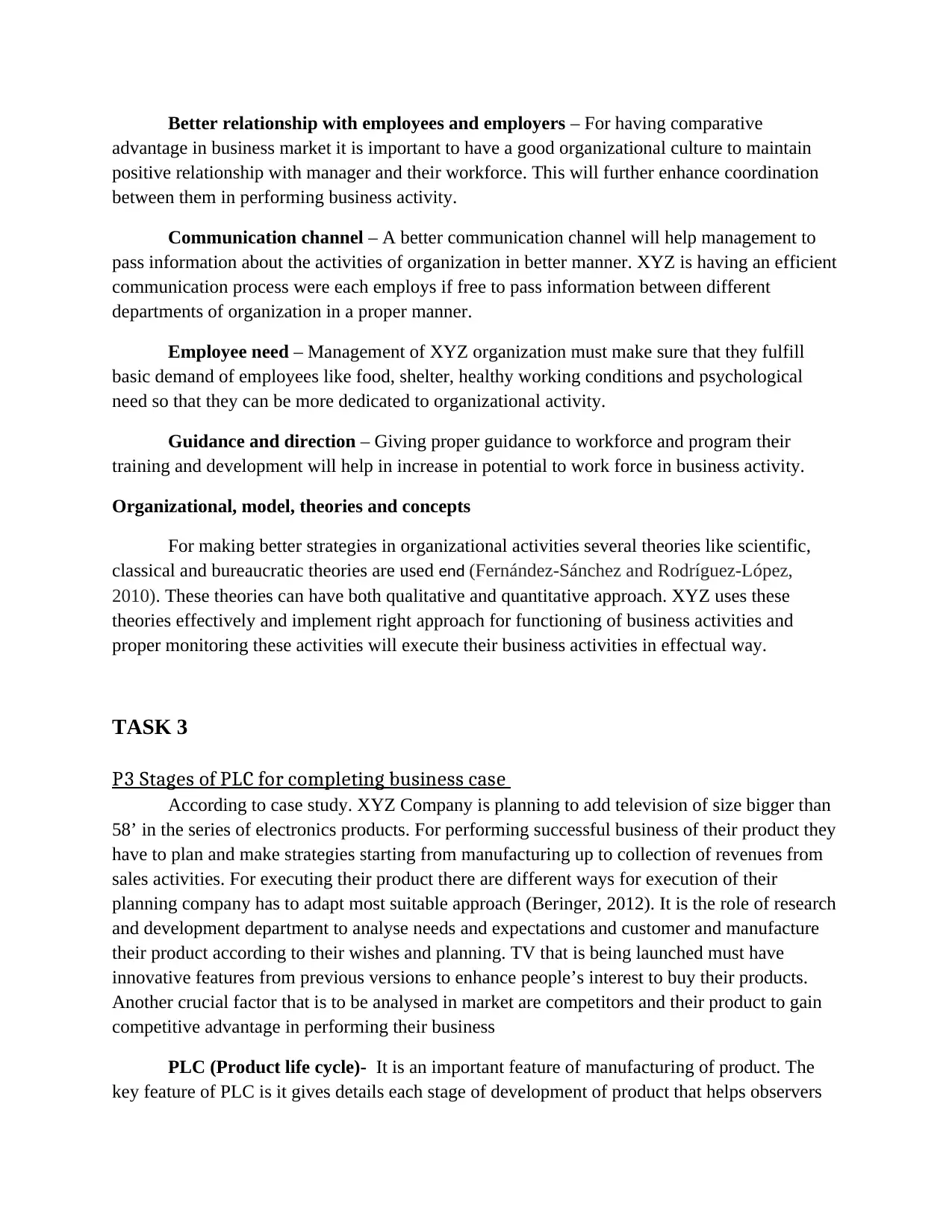
Better relationship with employees and employers – For having comparative
advantage in business market it is important to have a good organizational culture to maintain
positive relationship with manager and their workforce. This will further enhance coordination
between them in performing business activity.
Communication channel – A better communication channel will help management to
pass information about the activities of organization in better manner. XYZ is having an efficient
communication process were each employs if free to pass information between different
departments of organization in a proper manner.
Employee need – Management of XYZ organization must make sure that they fulfill
basic demand of employees like food, shelter, healthy working conditions and psychological
need so that they can be more dedicated to organizational activity.
Guidance and direction – Giving proper guidance to workforce and program their
training and development will help in increase in potential to work force in business activity.
Organizational, model, theories and concepts
For making better strategies in organizational activities several theories like scientific,
classical and bureaucratic theories are used end (Fernández-Sánchez and Rodríguez-López,
2010). These theories can have both qualitative and quantitative approach. XYZ uses these
theories effectively and implement right approach for functioning of business activities and
proper monitoring these activities will execute their business activities in effectual way.
TASK 3
P3 Stages of PLC for completing business case
According to case study. XYZ Company is planning to add television of size bigger than
58’ in the series of electronics products. For performing successful business of their product they
have to plan and make strategies starting from manufacturing up to collection of revenues from
sales activities. For executing their product there are different ways for execution of their
planning company has to adapt most suitable approach (Beringer, 2012). It is the role of research
and development department to analyse needs and expectations and customer and manufacture
their product according to their wishes and planning. TV that is being launched must have
innovative features from previous versions to enhance people’s interest to buy their products.
Another crucial factor that is to be analysed in market are competitors and their product to gain
competitive advantage in performing their business
PLC (Product life cycle)- It is an important feature of manufacturing of product. The
key feature of PLC is it gives details each stage of development of product that helps observers
advantage in business market it is important to have a good organizational culture to maintain
positive relationship with manager and their workforce. This will further enhance coordination
between them in performing business activity.
Communication channel – A better communication channel will help management to
pass information about the activities of organization in better manner. XYZ is having an efficient
communication process were each employs if free to pass information between different
departments of organization in a proper manner.
Employee need – Management of XYZ organization must make sure that they fulfill
basic demand of employees like food, shelter, healthy working conditions and psychological
need so that they can be more dedicated to organizational activity.
Guidance and direction – Giving proper guidance to workforce and program their
training and development will help in increase in potential to work force in business activity.
Organizational, model, theories and concepts
For making better strategies in organizational activities several theories like scientific,
classical and bureaucratic theories are used end (Fernández-Sánchez and Rodríguez-López,
2010). These theories can have both qualitative and quantitative approach. XYZ uses these
theories effectively and implement right approach for functioning of business activities and
proper monitoring these activities will execute their business activities in effectual way.
TASK 3
P3 Stages of PLC for completing business case
According to case study. XYZ Company is planning to add television of size bigger than
58’ in the series of electronics products. For performing successful business of their product they
have to plan and make strategies starting from manufacturing up to collection of revenues from
sales activities. For executing their product there are different ways for execution of their
planning company has to adapt most suitable approach (Beringer, 2012). It is the role of research
and development department to analyse needs and expectations and customer and manufacture
their product according to their wishes and planning. TV that is being launched must have
innovative features from previous versions to enhance people’s interest to buy their products.
Another crucial factor that is to be analysed in market are competitors and their product to gain
competitive advantage in performing their business
PLC (Product life cycle)- It is an important feature of manufacturing of product. The
key feature of PLC is it gives details each stage of development of product that helps observers
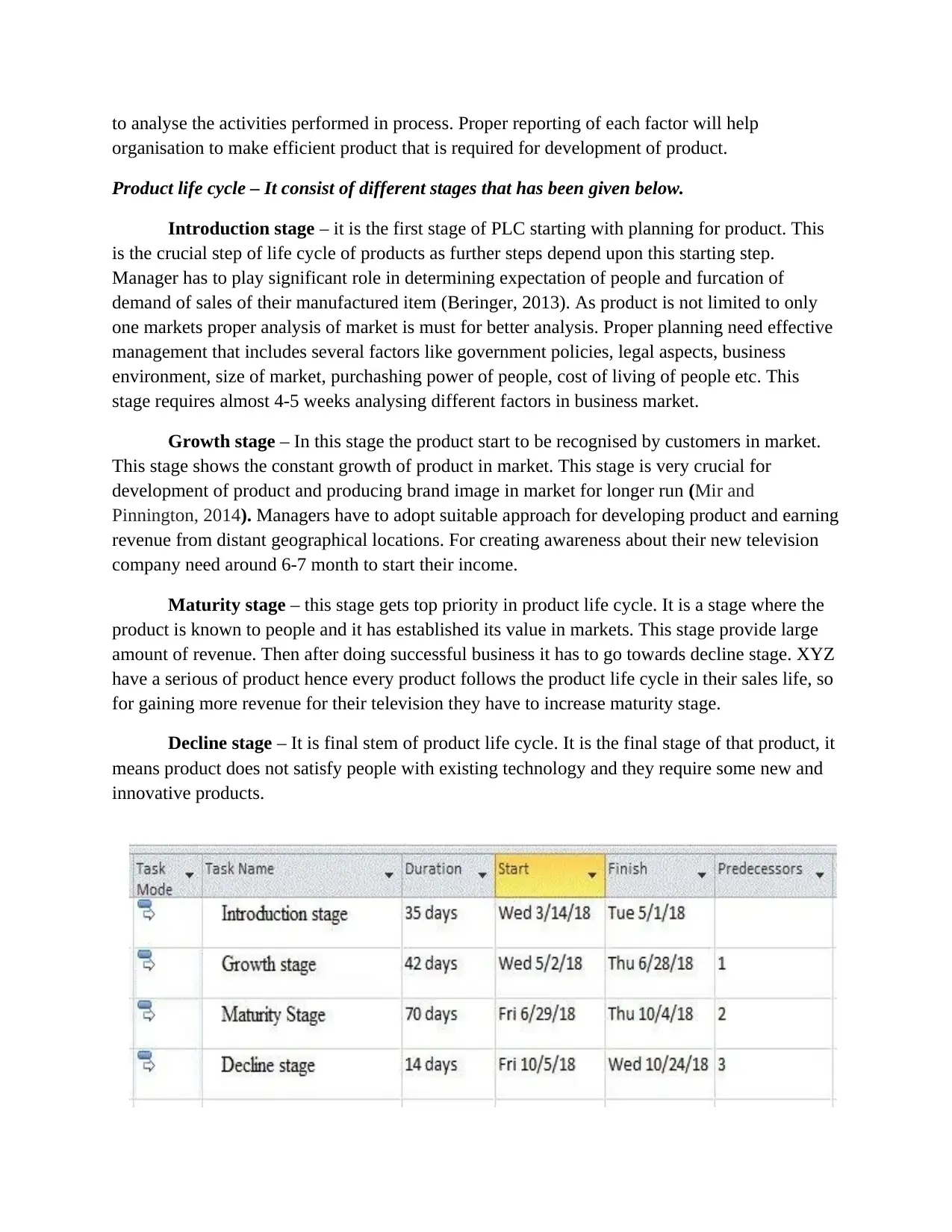
to analyse the activities performed in process. Proper reporting of each factor will help
organisation to make efficient product that is required for development of product.
Product life cycle – It consist of different stages that has been given below.
Introduction stage – it is the first stage of PLC starting with planning for product. This
is the crucial step of life cycle of products as further steps depend upon this starting step.
Manager has to play significant role in determining expectation of people and furcation of
demand of sales of their manufactured item (Beringer, 2013). As product is not limited to only
one markets proper analysis of market is must for better analysis. Proper planning need effective
management that includes several factors like government policies, legal aspects, business
environment, size of market, purchashing power of people, cost of living of people etc. This
stage requires almost 4-5 weeks analysing different factors in business market.
Growth stage – In this stage the product start to be recognised by customers in market.
This stage shows the constant growth of product in market. This stage is very crucial for
development of product and producing brand image in market for longer run (Mir and
Pinnington, 2014). Managers have to adopt suitable approach for developing product and earning
revenue from distant geographical locations. For creating awareness about their new television
company need around 6-7 month to start their income.
Maturity stage – this stage gets top priority in product life cycle. It is a stage where the
product is known to people and it has established its value in markets. This stage provide large
amount of revenue. Then after doing successful business it has to go towards decline stage. XYZ
have a serious of product hence every product follows the product life cycle in their sales life, so
for gaining more revenue for their television they have to increase maturity stage.
Decline stage – It is final stem of product life cycle. It is the final stage of that product, it
means product does not satisfy people with existing technology and they require some new and
innovative products.
organisation to make efficient product that is required for development of product.
Product life cycle – It consist of different stages that has been given below.
Introduction stage – it is the first stage of PLC starting with planning for product. This
is the crucial step of life cycle of products as further steps depend upon this starting step.
Manager has to play significant role in determining expectation of people and furcation of
demand of sales of their manufactured item (Beringer, 2013). As product is not limited to only
one markets proper analysis of market is must for better analysis. Proper planning need effective
management that includes several factors like government policies, legal aspects, business
environment, size of market, purchashing power of people, cost of living of people etc. This
stage requires almost 4-5 weeks analysing different factors in business market.
Growth stage – In this stage the product start to be recognised by customers in market.
This stage shows the constant growth of product in market. This stage is very crucial for
development of product and producing brand image in market for longer run (Mir and
Pinnington, 2014). Managers have to adopt suitable approach for developing product and earning
revenue from distant geographical locations. For creating awareness about their new television
company need around 6-7 month to start their income.
Maturity stage – this stage gets top priority in product life cycle. It is a stage where the
product is known to people and it has established its value in markets. This stage provide large
amount of revenue. Then after doing successful business it has to go towards decline stage. XYZ
have a serious of product hence every product follows the product life cycle in their sales life, so
for gaining more revenue for their television they have to increase maturity stage.
Decline stage – It is final stem of product life cycle. It is the final stage of that product, it
means product does not satisfy people with existing technology and they require some new and
innovative products.
⊘ This is a preview!⊘
Do you want full access?
Subscribe today to unlock all pages.

Trusted by 1+ million students worldwide
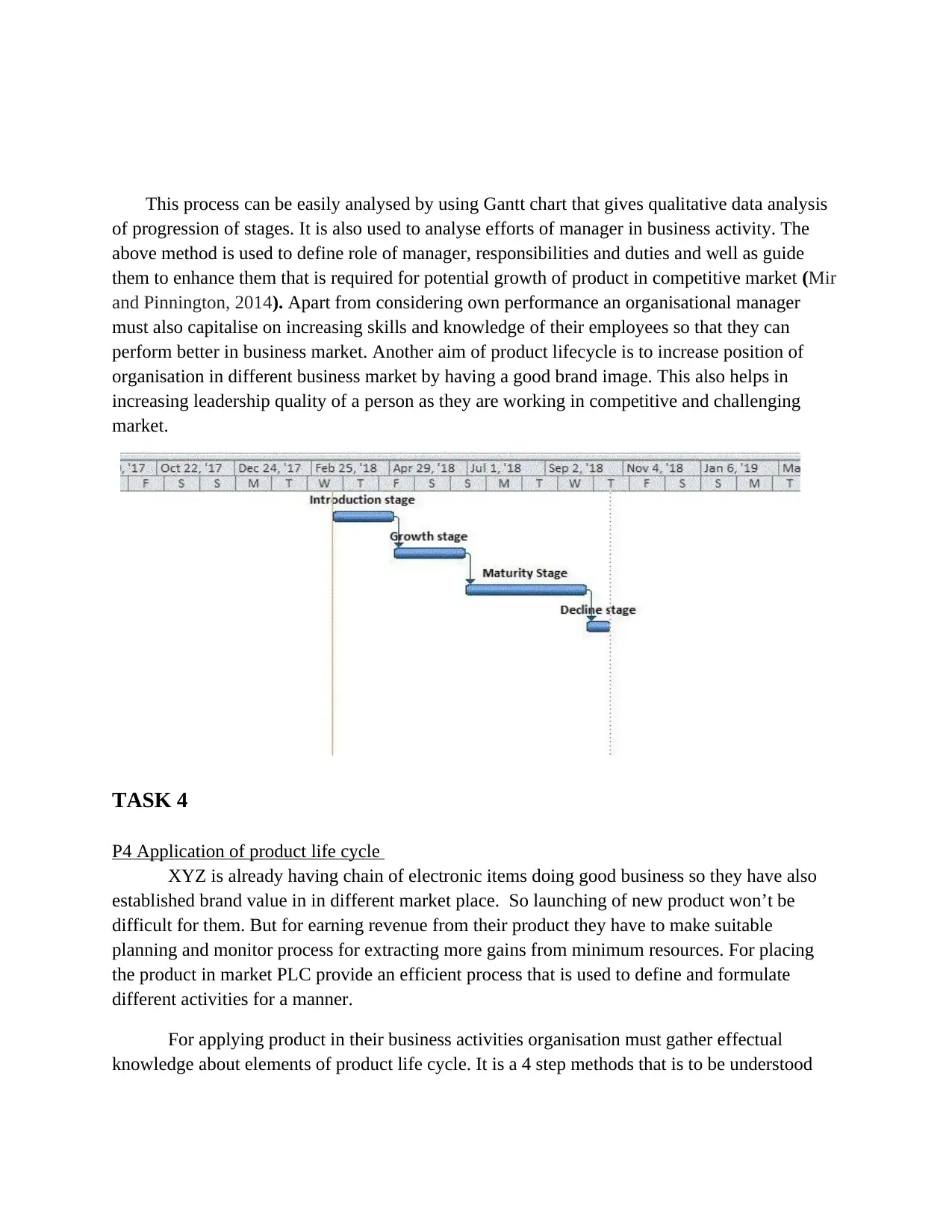
This process can be easily analysed by using Gantt chart that gives qualitative data analysis
of progression of stages. It is also used to analyse efforts of manager in business activity. The
above method is used to define role of manager, responsibilities and duties and well as guide
them to enhance them that is required for potential growth of product in competitive market (Mir
and Pinnington, 2014). Apart from considering own performance an organisational manager
must also capitalise on increasing skills and knowledge of their employees so that they can
perform better in business market. Another aim of product lifecycle is to increase position of
organisation in different business market by having a good brand image. This also helps in
increasing leadership quality of a person as they are working in competitive and challenging
market.
TASK 4
P4 Application of product life cycle
XYZ is already having chain of electronic items doing good business so they have also
established brand value in in different market place. So launching of new product won’t be
difficult for them. But for earning revenue from their product they have to make suitable
planning and monitor process for extracting more gains from minimum resources. For placing
the product in market PLC provide an efficient process that is used to define and formulate
different activities for a manner.
For applying product in their business activities organisation must gather effectual
knowledge about elements of product life cycle. It is a 4 step methods that is to be understood
of progression of stages. It is also used to analyse efforts of manager in business activity. The
above method is used to define role of manager, responsibilities and duties and well as guide
them to enhance them that is required for potential growth of product in competitive market (Mir
and Pinnington, 2014). Apart from considering own performance an organisational manager
must also capitalise on increasing skills and knowledge of their employees so that they can
perform better in business market. Another aim of product lifecycle is to increase position of
organisation in different business market by having a good brand image. This also helps in
increasing leadership quality of a person as they are working in competitive and challenging
market.
TASK 4
P4 Application of product life cycle
XYZ is already having chain of electronic items doing good business so they have also
established brand value in in different market place. So launching of new product won’t be
difficult for them. But for earning revenue from their product they have to make suitable
planning and monitor process for extracting more gains from minimum resources. For placing
the product in market PLC provide an efficient process that is used to define and formulate
different activities for a manner.
For applying product in their business activities organisation must gather effectual
knowledge about elements of product life cycle. It is a 4 step methods that is to be understood
Paraphrase This Document
Need a fresh take? Get an instant paraphrase of this document with our AI Paraphraser
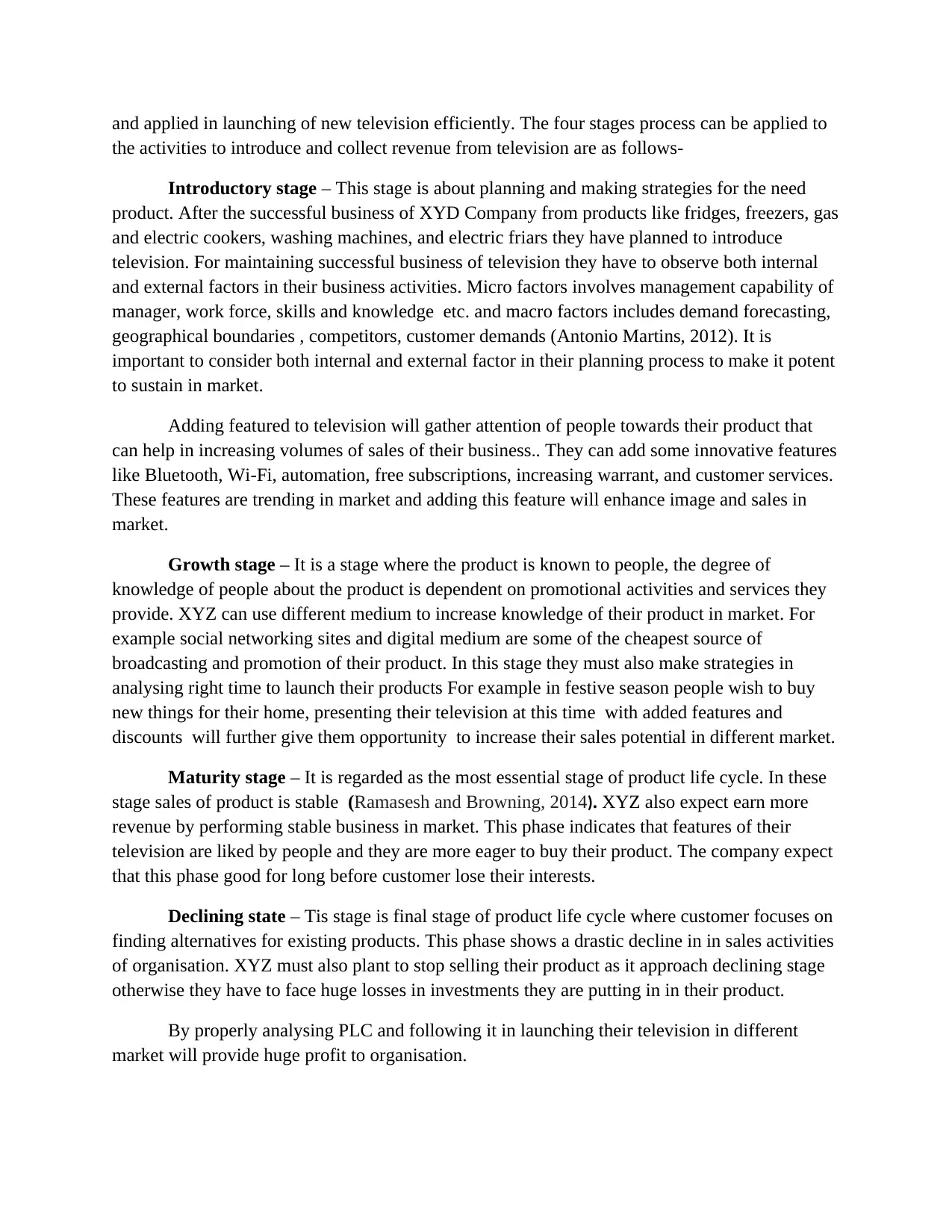
and applied in launching of new television efficiently. The four stages process can be applied to
the activities to introduce and collect revenue from television are as follows-
Introductory stage – This stage is about planning and making strategies for the need
product. After the successful business of XYD Company from products like fridges, freezers, gas
and electric cookers, washing machines, and electric friars they have planned to introduce
television. For maintaining successful business of television they have to observe both internal
and external factors in their business activities. Micro factors involves management capability of
manager, work force, skills and knowledge etc. and macro factors includes demand forecasting,
geographical boundaries , competitors, customer demands (Antonio Martins, 2012). It is
important to consider both internal and external factor in their planning process to make it potent
to sustain in market.
Adding featured to television will gather attention of people towards their product that
can help in increasing volumes of sales of their business.. They can add some innovative features
like Bluetooth, Wi-Fi, automation, free subscriptions, increasing warrant, and customer services.
These features are trending in market and adding this feature will enhance image and sales in
market.
Growth stage – It is a stage where the product is known to people, the degree of
knowledge of people about the product is dependent on promotional activities and services they
provide. XYZ can use different medium to increase knowledge of their product in market. For
example social networking sites and digital medium are some of the cheapest source of
broadcasting and promotion of their product. In this stage they must also make strategies in
analysing right time to launch their products For example in festive season people wish to buy
new things for their home, presenting their television at this time with added features and
discounts will further give them opportunity to increase their sales potential in different market.
Maturity stage – It is regarded as the most essential stage of product life cycle. In these
stage sales of product is stable (Ramasesh and Browning, 2014). XYZ also expect earn more
revenue by performing stable business in market. This phase indicates that features of their
television are liked by people and they are more eager to buy their product. The company expect
that this phase good for long before customer lose their interests.
Declining state – Tis stage is final stage of product life cycle where customer focuses on
finding alternatives for existing products. This phase shows a drastic decline in in sales activities
of organisation. XYZ must also plant to stop selling their product as it approach declining stage
otherwise they have to face huge losses in investments they are putting in in their product.
By properly analysing PLC and following it in launching their television in different
market will provide huge profit to organisation.
the activities to introduce and collect revenue from television are as follows-
Introductory stage – This stage is about planning and making strategies for the need
product. After the successful business of XYD Company from products like fridges, freezers, gas
and electric cookers, washing machines, and electric friars they have planned to introduce
television. For maintaining successful business of television they have to observe both internal
and external factors in their business activities. Micro factors involves management capability of
manager, work force, skills and knowledge etc. and macro factors includes demand forecasting,
geographical boundaries , competitors, customer demands (Antonio Martins, 2012). It is
important to consider both internal and external factor in their planning process to make it potent
to sustain in market.
Adding featured to television will gather attention of people towards their product that
can help in increasing volumes of sales of their business.. They can add some innovative features
like Bluetooth, Wi-Fi, automation, free subscriptions, increasing warrant, and customer services.
These features are trending in market and adding this feature will enhance image and sales in
market.
Growth stage – It is a stage where the product is known to people, the degree of
knowledge of people about the product is dependent on promotional activities and services they
provide. XYZ can use different medium to increase knowledge of their product in market. For
example social networking sites and digital medium are some of the cheapest source of
broadcasting and promotion of their product. In this stage they must also make strategies in
analysing right time to launch their products For example in festive season people wish to buy
new things for their home, presenting their television at this time with added features and
discounts will further give them opportunity to increase their sales potential in different market.
Maturity stage – It is regarded as the most essential stage of product life cycle. In these
stage sales of product is stable (Ramasesh and Browning, 2014). XYZ also expect earn more
revenue by performing stable business in market. This phase indicates that features of their
television are liked by people and they are more eager to buy their product. The company expect
that this phase good for long before customer lose their interests.
Declining state – Tis stage is final stage of product life cycle where customer focuses on
finding alternatives for existing products. This phase shows a drastic decline in in sales activities
of organisation. XYZ must also plant to stop selling their product as it approach declining stage
otherwise they have to face huge losses in investments they are putting in in their product.
By properly analysing PLC and following it in launching their television in different
market will provide huge profit to organisation.
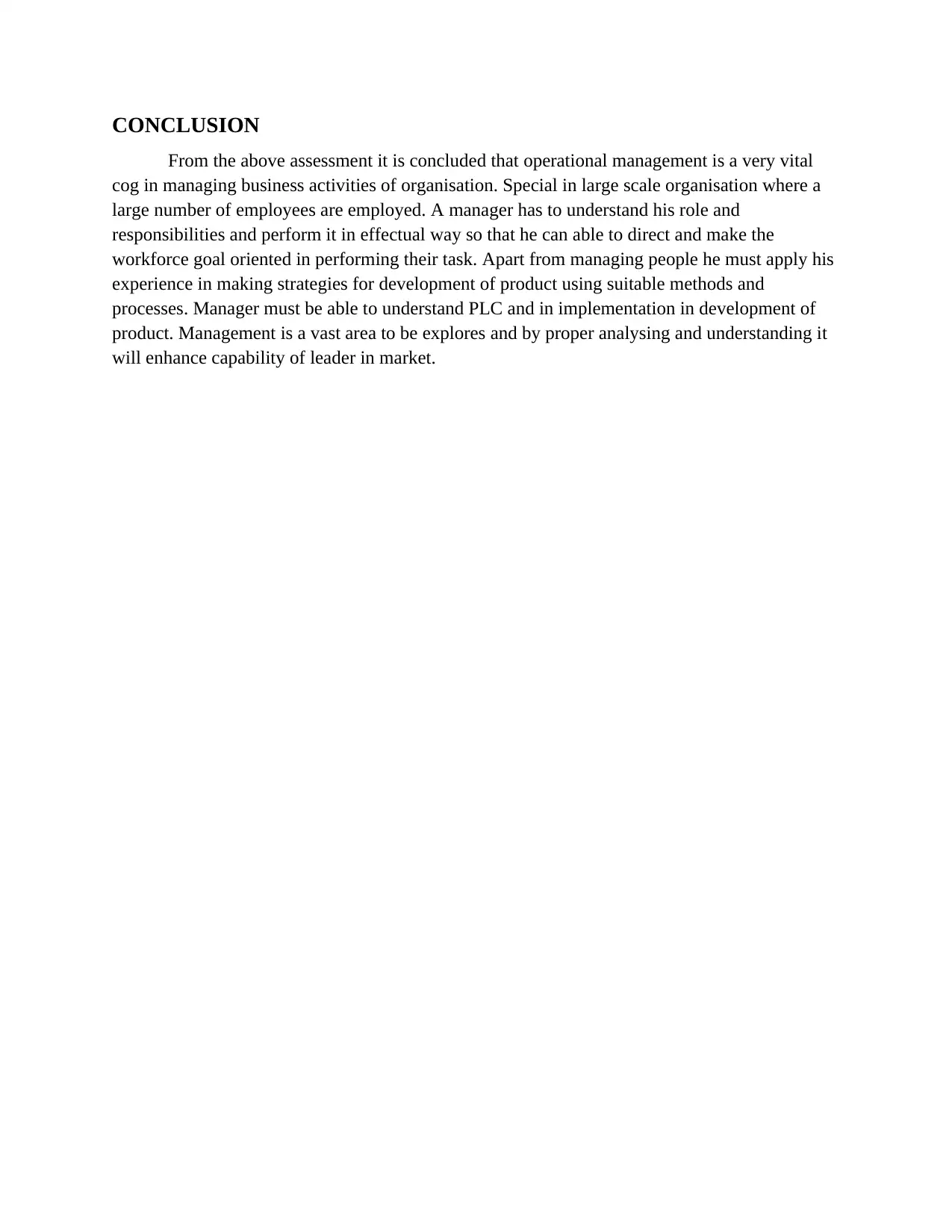
CONCLUSION
From the above assessment it is concluded that operational management is a very vital
cog in managing business activities of organisation. Special in large scale organisation where a
large number of employees are employed. A manager has to understand his role and
responsibilities and perform it in effectual way so that he can able to direct and make the
workforce goal oriented in performing their task. Apart from managing people he must apply his
experience in making strategies for development of product using suitable methods and
processes. Manager must be able to understand PLC and in implementation in development of
product. Management is a vast area to be explores and by proper analysing and understanding it
will enhance capability of leader in market.
From the above assessment it is concluded that operational management is a very vital
cog in managing business activities of organisation. Special in large scale organisation where a
large number of employees are employed. A manager has to understand his role and
responsibilities and perform it in effectual way so that he can able to direct and make the
workforce goal oriented in performing their task. Apart from managing people he must apply his
experience in making strategies for development of product using suitable methods and
processes. Manager must be able to understand PLC and in implementation in development of
product. Management is a vast area to be explores and by proper analysing and understanding it
will enhance capability of leader in market.
⊘ This is a preview!⊘
Do you want full access?
Subscribe today to unlock all pages.

Trusted by 1+ million students worldwide
1 out of 13
Related Documents
Your All-in-One AI-Powered Toolkit for Academic Success.
+13062052269
info@desklib.com
Available 24*7 on WhatsApp / Email
![[object Object]](/_next/static/media/star-bottom.7253800d.svg)
Unlock your academic potential
Copyright © 2020–2025 A2Z Services. All Rights Reserved. Developed and managed by ZUCOL.





